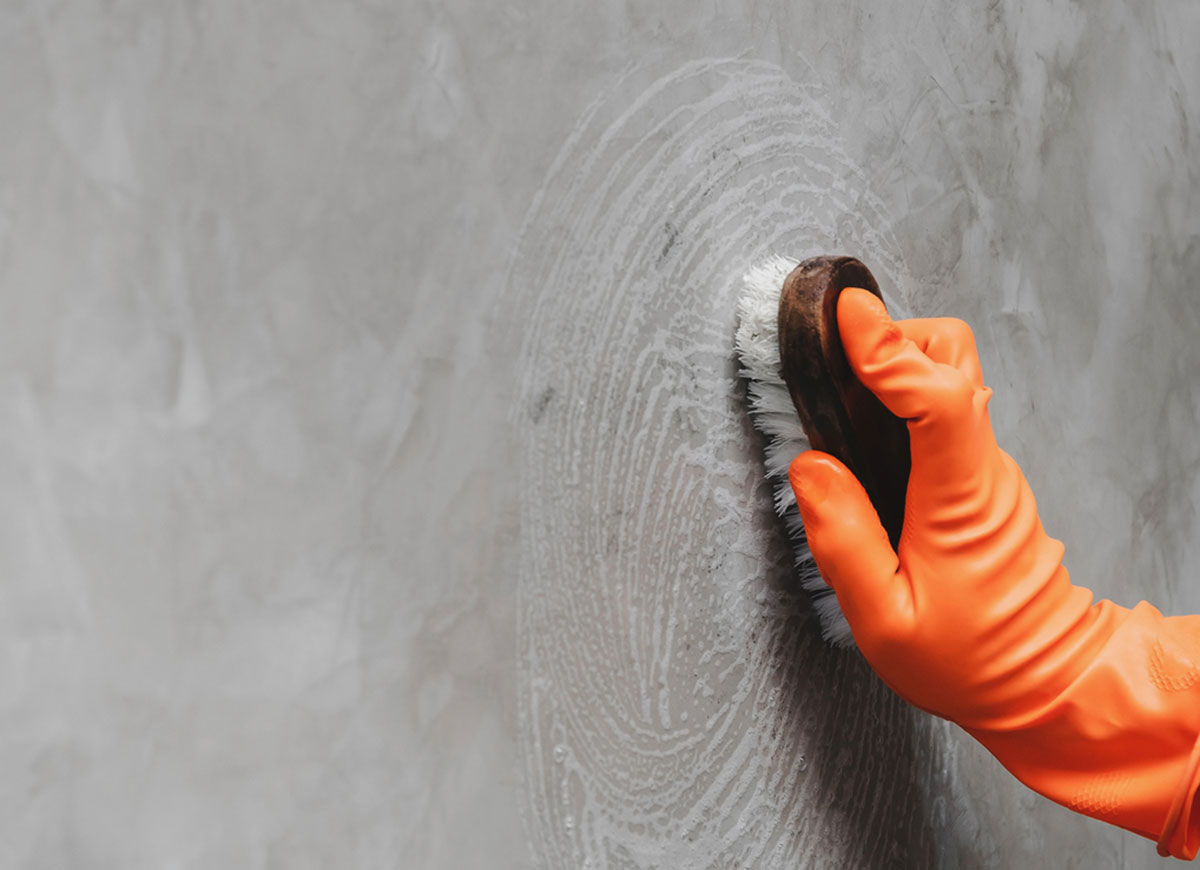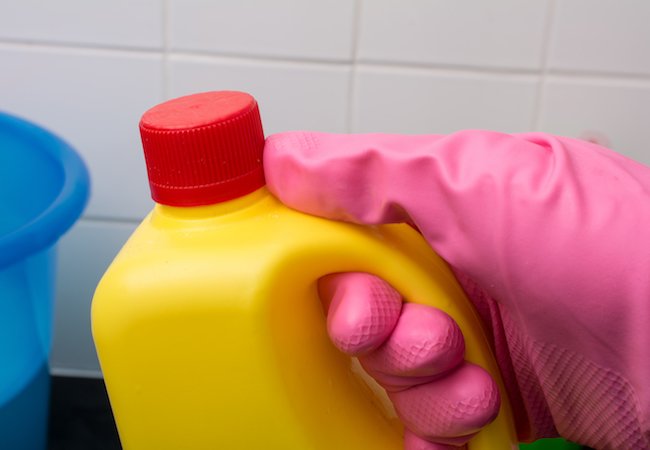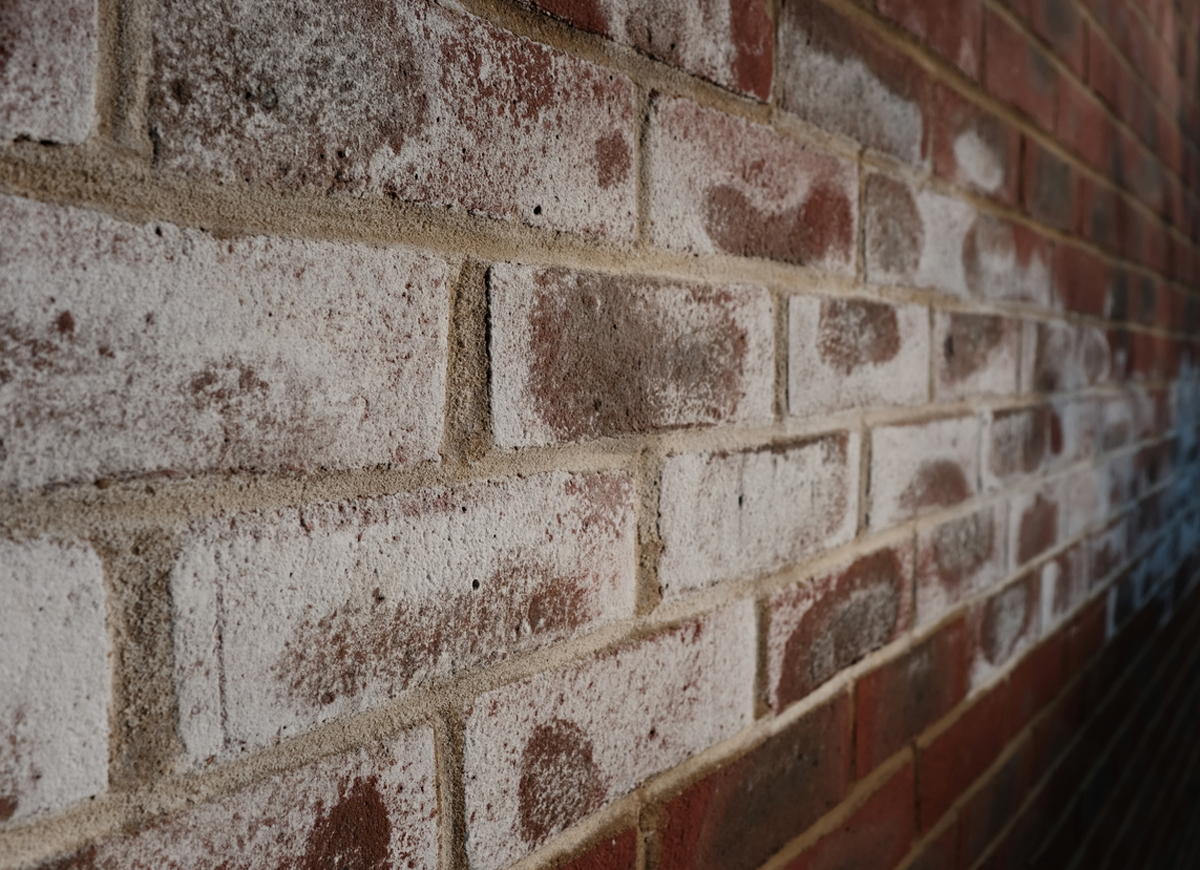

We may earn revenue from the products available on this page and participate in affiliate programs. Learn More ›
Muriatic acid, a less-pure variant of hydrochloric acid, is available in high concentrations for use in a host of home restoration and maintenance projects.
While this powerful chemical agent runs cheap—about $10 a gallon at home centers, hardware stores, and even on Amazon—it’s still very caustic stuff, capable of corroding everything from some plastics and metals to clothing and skin. In fact, working with it poses numerous health risks: Momentary skin exposure can cause severe burns, inhaling its fumes can burn lung and nose lining, and contact can also cause irreversible eye damage or blindness.
Homeowners should never reach for muriatic acid lightly. Instead, consider it a “last resort” when less toxic products fail to do the trick in cleaning, prepping, deoxidizing, or removing mold from masonry, concrete, metal, and swimming pools. Before you begin any project with this multipurpose substance, read on, first for guidance in using it safely, and then for its range of practical applications around the house.
Muriatic Acid vs. Hydrochloric Acid
Muriatic acid is a form of hydrochloric acid, as mentioned earlier. But while hydrochloric acid contains only HCI molecules, muriatic acid is made up of HCI molecules as well as impurities such as iron.
Other differences include muriatic acid’s slightly yellow color, a result of the additional iron content, compared to hydrochloric acid’s colorless appearance. And while muriatic acid is a potent cleaner that should be used with extreme caution around the house, it pales in comparison to the strength of pure hydrochloric acid, which is mostly used in laboratory settings with diligent safety measures in place.

Essential Safety Measures with Muriatic Acid
Due to all of the damage this chemical could cause in one wrong move, extreme caution is mandatory when using, storing, and disposing of muriatic acid. Adhere to the following best practices before beginning any project that involves the acid:
- Wear full-face protection, a respirator, thick, full-coverage clothing, and acid-resistant protective gloves.
- Muriatic acid must be diluted in water. Though degree of dilution will vary depending on the job, the general formula is one-part muriatic acid to 10 parts water.
- When making a dilution, slowly and carefully pour the acid into the water. Never add water to acid, as an exothermic reaction will occur, propelling the acid out of the container and onto you.
- Never pour muriatic acid into an empty vessel. Fill the container with the right amount of water before adding the acid.
- Never mix muriatic acid with other acids.
- Only mix muriatic acid in a glass or acid-resistant plastic container.
- Always store muriatic acid in the container it came in.
- Keep a supply of baking soda or garden lime nearby in case you need to quickly neutralize muriatic acid. While sprinkling these substances full-strength will work, the best plan is to mix ½ cup of baking soda and a quart of water in a sealed spray bottle and keep it nearby.
- Work with a hose or large container of water nearby to wash skin in case of accidental splashing.
- If using muriatic acid on large surface areas, it will need to be applied with a plastic sprayer. The plastic is bound to deteriorate quickly, so you’ll likely need more than one to complete the job.
- Contact your local recycling center for instructions on safe disposal of muriatic acid in your area.
Effective Uses for Muriatic Acid
Practice all the safety precautions above, and you should be able to use muriatic acid with great success. Here are six projects where you might find it indispensable:
- Neutralizing alkalinity in masonry. Masonry alkalinity can discolor or burn off paint finishes. Washing brick, concrete, or stone with muriatic acid can neutralize alkalinity, allowing paint finishes to last for years. Brush or spray on a 1:10 diluted mix of acid in water onto the surface, allow it to sit for up to 10 minutes, but no longer, then spray it with a solution of 1 cup ammonia in a gallon of water to neutralize the acid. Allow the surface to dry completely before applying paint or other treatments.

- Removing efflorescence and prepping masonry for paint. Efflorescence refers to the white crystalline blooming that can occur on masonry surfaces, including brick and concrete. Often a sign that masonry contains too much moisture, efflorescence may indicate that a sealant is needed to contain moisture issues. Prior to applying sealant, however, efflorescence must be removed. Likewise, if you want to paint masonry, the surface needs to be “etched.” You can remove efflorescence and etch a masonry surface in one shot: Apply a 1:10 dilution of muriatic acid to water, let sit for a few minutes until you see the efflorescence lifting, then brush with a stiff nylon brush to remove residue. Spray down the surface afterwards with a 1:16 ammonia-water neutralizing solution.
- Basement makeover. Fight mold and mildew in your basement while restoring surface appearance with muriatic acid. Just be sure to ventilate the basement as much as possible, and wear a respirator. Apply a 1:9 acid-to-water dilution, scrub visible mold patches on hard surfaces like concrete, bricks, and on some glazed tiles and grout, with a stiff nylon brush, and rinse thoroughly by hosing down with water. Use a wet vac to suck up excess water. Air the basement out for a few hours after this task is completed.
- Busting rust. The use of muriatic acid to remove rust on metal is a contentious topic, as the substance can potentially lead to more rapid oxidization in the future. So the cautious DIYer should only use it only on stainless steel (and never cast iron) that will be painted after rust removal. Brush the acid on at a 1:10 acid/water dilution and scrub with a nylon brush. Immediately after removing rust, neutralize the acid with a baking soda-water paste (1:1). Apply paste generously so it thoroughly coats acid-washed and let sit for 10 minutes and then rinse with water, dry, and prep for paint. (Find more specific how-to info here.)
- Swimming pool maintenance. Muriatic acid can get your swimming pool’s surface looking like new again. Spray a 1:16 acid-to-water diluted solution on the drained surface of the pool, let it sit for 10 to 15 minutes. For stubborn stains, scrub with a nylon brush. Rinse thoroughly with plain water.
- Swimming pool pH balance. If the pool’s pH level is too high, muriatic acid can bring balance to the water. Purchase “swimming pool acid” for this maintenance task. Though nothing more than muriatic acid—and the same price—it will have thorough instructions and formulas for use in a swimming pool. You’ll added it in, re-test the pH levels after a few hours and once it’s back in range, you’ll be ready for that dip!
How to Dispose of Muriatic Acid
Like many potent chemicals used for cleaning and repair, muriatic acid cannot be dumped down the drain or anywhere on your property. It must be disposed of safely to avoid harming your home and the environment.
First things first, don’t try neutralizing the used or leftover acid yourself. Instead, call your local recycling center, as they will be best equipped to walk you through the proper steps for disposing of muriatic acid. Likely, they’ll advise you to simply seal up the container it’s in and bring it to a location designed to deal with hazardous household waste.
